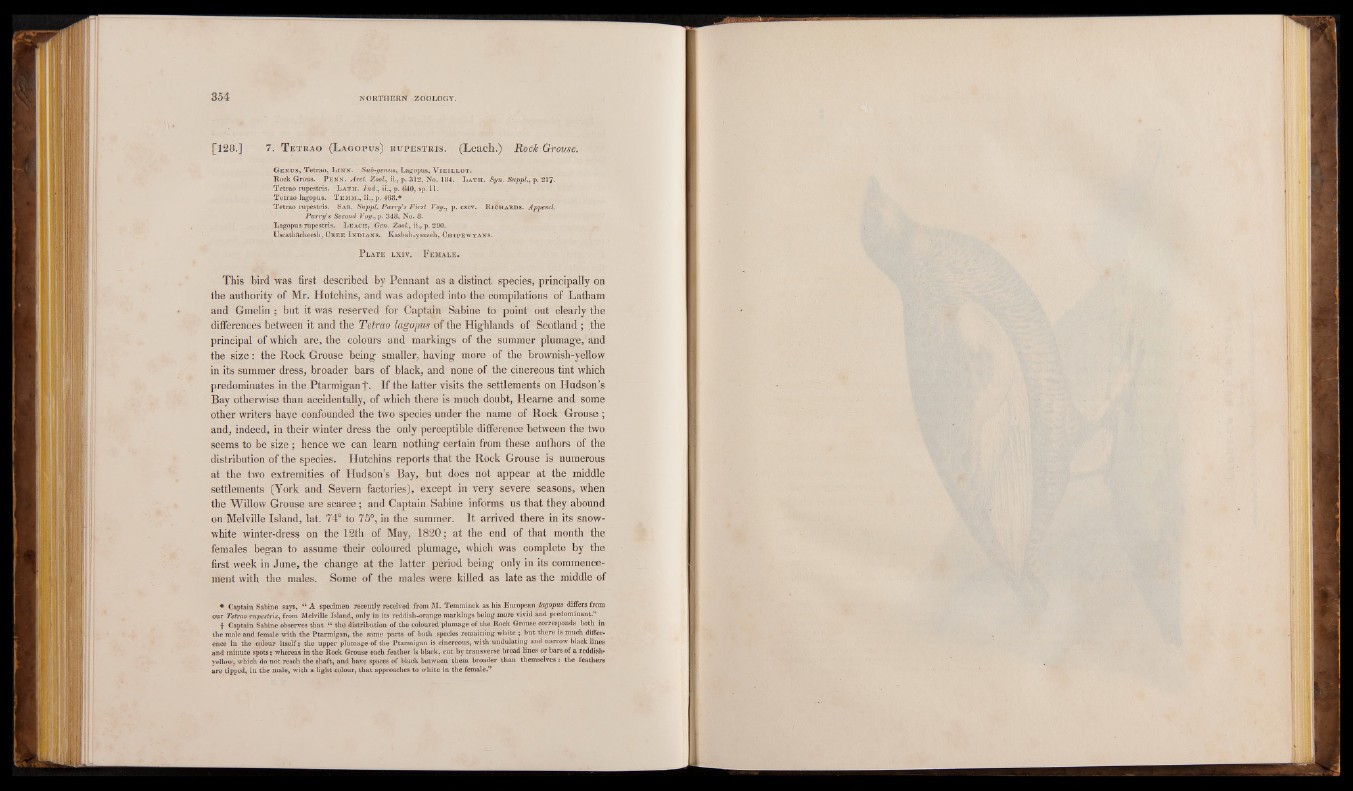
[128.] 7. T e t r a o (L a g o p u s ) r u p e s t r is . (Leach.) Rock Grouse.
Ge n u s , Tetrao, L in n . Sub-genus, Lagopus, V i e il l o t .
Bock Grous. P e n n . Arct. Zool.. ii., p. 312, No. 184. L a t h . Syn. Supply p. 217-
Tetrao rupestris. Lath. Ind., ii., p. 640, sp. 11.
Tetrao lagopus. Temm., ii., p. 468.*
Tetrao rupestris. Sab. Suppl. Parry's First Voy., p. cxcv. R ic h a r d s . Append.
Parry's Second Voy., p. 348, No. 8.
Lagopus rupestris. L each , Gen. Zool., ii., p. 290.
Uscathacheesh, Cb.e e I n d ia n s . Kasbah-yazzeh, Ch ip ew y a n s .
P late lx iv. F em a le.
This bird was first described by Pennant as a distinct species, principally on
the authority of Mr. Hutchins, and was adopted into the compilations of Latham
and Gmelin; but it was reserved for Captain Sabine to point out clearly the
differences betweeirit and the Tetrao lagopus of the Highlands of Scotland ; the
principal of which are, the colours and markings of the summer plumage, and
the size: the Rock Grouse being smaller, having more of the brownish-yellow
in its summer dress, broader bars of black, and none of the cinereous tint which
predominates in the Ptarmigan t. If the latter visits the settlements on Hudson’s
Bay otherwise than accidentally, of which there is much doubt, Hearne and some
other writers have confounded the two species under the name of Rock Grouse;
and, indeed, in their winter dress the only perceptible difference between the two
seems to be size ; hence we can learn nothing certain from these authors of the
distribution of the species. Hutchins reports that the Rock Grouse is numerous
at the two extremities of Hudson’s Bay, but does not appear at the middle
settlements (York and Severn factories), except in very severe seasons, when
the Willow Grouse are scarce; and Captain Sabine informs us that they abound
on Melville Island, lat. 74° to 75°, in the summer. It arrived there in its snow-
white winter-dress on the 12th of May, 1820; at the end of that month the
females began to assume their coloured plumage, which was complete by the
first week in June, the change at the latter period being only in its commencement
with the males. Some of the males were killed as late as the middle of
• Captain Sabine says, “ A specimen recently received from M. Temminck as his European lagopus differs from
our Tetrao rupestris, from Melville Island, only in its reddish-orange markings being more vivid and predominant.”
■ f Captain Sabine observes that “ the distribution of the coloured"plumage of the Rock Grouse corresponds both in
the male and female with the Ptarmigan, the same parts of both species remaining white ; but there is much differ*
ence in the cplour itself; the upper plumage of the Ptarmigan is cinereous, with undulating and narrow black lines
and minute spots; whereas in the Rock Grouse each feather is black, cut by transverse broad lines or bars of a reddish-
yellow, which do not reach the shaft, and have spaces of black between them broader than themselves : the feathers
are tipped, in the male, with a light colour, that approaches to white in the female.”